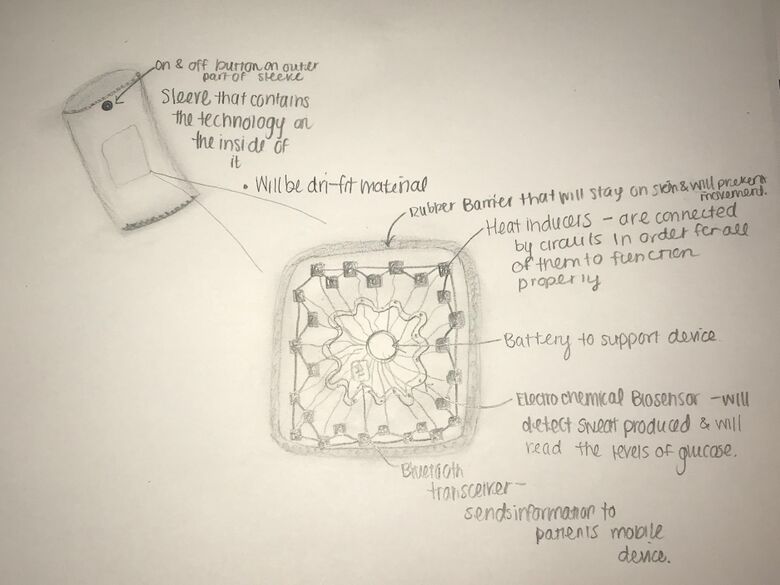BME100 f2017:Group4 W0800 L2
| Home People Lab Write-Up 1 | Lab Write-Up 2 | Lab Write-Up 3 Lab Write-Up 4 | Lab Write-Up 5 | Lab Write-Up 6 Course Logistics For Instructors Photos Wiki Editing Help | ||||||
OUR TEAM
LAB 2 WRITE-UPDevice Image and Description This new form of glucose monitoring device would be able to measure levels of glucose in patients, without the the painful burden of having to pinch their finger throughout the day. This lowers the discomfort in patients and allows them to easily see their critical numbers fast when it comes to diabetes and glucose. Glucose found in sweat will be measured. Sweat will be collected and will be produced with the help of heat inducers. All recorded information will be sent to the patient's mobile device through Bluetooth.
Technical and Clinical FeasibilityTechnical Feasibility Some challenges that could come from our device are how well a battery could work. It may be hard to find a good, long lasting battery. Another challenge could be that the heating technology will not work correctly, and will basically make our whole device dysfunctional. A main challenge could be that someone could develop something extremely similar but get it approved and processed first. Things that could go wrong are that the battery could run out quicker than projected and it not being able to record the levels of glucose. Another possibility could be that the heat inducer will not heat enough to produce the amount of heat needed for the patient's body to produce sweat. This could limit the accuracy of the sweat reading and glucose levels provided. Another possible disadvantage is that the device will not pair properly with the patient's mobile device and they will not receive the information that is being obtained. Clinical Feasibility Market AnalysisValue Creation Manufacturing Cost The market price of electrochemical sensors seems to range from about $150 to $500. We think that the sensors inside of our product with be on the more expensive side of the spectrum because of the advanced technology it takes to get accurate glucose readings. We estimate the cost of production of the expensive sensors by dividing the market price(500) by five(5), to get a cost of $100. The Bluetooth technology that our device requires is a relatively low cost technology. The most significant cost of this is the license that the manufacturers are required to get. For this part of our device, we added $50 into our unit cost of production. The last significant part to our device is the heaters to induce sweat. This will be a relatively low cost and will contribute $25 to the unit price of production. The estimation of the cost it will take to manufacture one device will be about $200 dollars with the fees of manufacturing and extra materials. Sales Price We believe that the market value of our device is five times the quantity of the cost of production. People with diabetes, who have experienced the current invasive methods of measuring glucose will definitely be willing to pay $1000 for this device. Market Size
Fundability DiscussionCustomer Validation - 2 The current methods of treating diabetes is so painful and invasive, that a significant amount of interest has been expressed for the creation of something better. This product is highly sought after by a large group of people. Market Size - 2 Our market size score is two because almost 450 million people in the world have diabetes. This is a very strong market size. Competition - 2 There is currently a few competitors for this product, but they have yet to accomplish the goal of an accurate technology that is ready to put on the market. If this product were successfully executed, it would stand a very good chance in the market. IP Position - 1 Currently it is very hard to find patents for this kind of device. This might be a possible setback for the production of this device. Technical Feasibility - 2 The technologies within device are advanced, but they are reasonable. There are challenges created by the accuracy of measuring glucose in sweat, but we can overcome these with a reasonable amount of cost and research. Regulatory Pathway - 1 It is likely that it would need a PMA(Pre-market approval) before this device could be put on the market. Clinical Feasibility - 2 The likelihood of having clinical success with the technology in this device is very high. Getting successful clinical results would take stong expertise for the problem of the measurement accuracy, but it is highly probable. Reimbursement - 3 Diabetes is a very serious problem, so the people who are affected by it are definitely willing to pay cash for a device like this. This makes the situation of reimbursement to investors a very positive one. Discussion With the scores that this potential device received for fundability, we believe that this device would be worth the research and cost of successfully achieving it. Developing the technology to make this device is possible and would benefit the lives of people living with diabetes. ResourcesHow does Bluetooth work? https://www.scientificamerican.com/article/experts-how-does-bluetooth-work/ (accessed Sep 20, 2017). Where To Find It | Bluetooth Technology Website https://www.bluetooth.com/what-is-bluetooth-technology/where-to-find-it (accessed Sep 20, 2017). Electrochemical Sensors & Biosensors | CTI http://www.conductivetech.com/products/electrochemical-sensors/ (accessed Sep 20, 2017). Macroduct® Sweat Collection System https://www.elitechgroup.com/product/macroduct-sweat-collection-system/ (accessed Sep 20, 2017).
|
||||||
